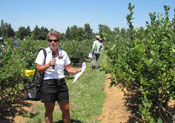In Blueberry Markets, ‘We Have Met the Enemy, And He Is Us’
World blueberry production is increasing, but, according to Dave Brazelton of Fall Creek Farm and Nursery in Lowell, Oregon, the increase is having little effect on Pacific Northwest producers.
“Production outside of the Americas does not directly affect the Pacific Northwest,” Brazelton said. “It doesn’t affect our pricing and it doesn’t affect our markets.
 |
Dave Brazelton of Fall Creek Farm and Nursery speaks to the 2019 Oregon Blueberry Conference. |
“It is really about what we are doing here right now,” Brazelton said. “That volume of Duke and Draper that comes on from the tenth of July until the end of July really defines what kind of year we will have.”
In a presentation at the 2019 Oregon Blueberry Conference, Brazelton said Pacific Northwest producers face some domestic competition during its peak fresh period. “Fresh production from New Jersey and Michigan overlaps with the Pacific Northwest and some rabbiteyes from Georgia and North Carolina show up,” he said. But, even here, the Pacific Northwest dominates and its dominance continues to grow.
“We had 61 percent of that market in 2015,” he said. “If you go back to 2010, that was below 50 percent. And the further you go back, the smaller it gets. In 2018, the Pacific Northwest had 72 percent of the fresh summertime blueberry market.”
There are several reasons why this is occurring, he said. In the case of domestic competition, producers in other regions of the U.S. are having difficulty consistently supplying markets due to dramatic crop fluctuations.
“The Eastern supply is much more volatile than the West,” Brazelton said. Georgia’s production, for example, dropped from 85 million pounds in 2015 to just 30 million pounds in 2017 due to killing frosts and heavy summer rains. Production rebounded slightly in 2018, to 50 million pounds, but was still well below its peak.
“They haven’t been pulling out acreage,” Brazelton said. “They just are in a highly vulnerable area.”
Florida, too, rebounded from a disastrous 2017, Brazelton said. But North Carolina had a tough year and Michigan produced just 66 million pounds in 2018, down from a 100 million pound crop just two years earlier. With the cold snaps Michigan experienced this winter, some expect its 2019 production to be down significantly, as well.
On an international level, producers from South America and Mexico aren’t hitting the market during the Pacific Northwest’s peak fresh season. “In our late window, Peru is in position to compete and we should expect that in the future, however, they have access to markets around the world in many consuming regions where competition is slight,” Brazelton said. “If we are able to produce quality fruit in our late window, we should compete very well.”
The Pacific Northwest, by contrast to other U.S. production regions, has steadily increased production, although the rate of growth has flattened in recent years.
“The Pacific Northwest mostly competes with the Pacific Northwest,” Brazelton said. “We have met the enemy, and he is us.”
Globally, production hit a record 1.7 billion pounds in 2018, as it continues to grow at a rate of 250 million to 300 million pounds a year. Much of the increase is occurring in Peru.
“Peru will be the largest production country outside of the U.S. in a year or two,” Brazelton predicted.
Production in Mexico also continues to expand, moving from just 34 million pounds in 2016 to 65 million pounds this year. “Expect that to move up to 100 million pounds,” Brazelton said. “It might even get up to 120 million.”
Most of the growth in Mexico is happening in Central Mexico, he said, and goes almost exclusively to the fresh market, where Mexico competes against Peru, Chile and other countries that compete in the November-through-April market window.
“Will they go earlier and compete with us? I don’t think so,” Brazelton said. “They can’t manipulate the plants to produce reliably in their off season.”
Chilean blueberry production continues to grow, as well, but not as rapidly as it has in the recent past, Brazelton said. He added that much of Chile’s growth is in processed fruit, as Chilean producers transition to new varieties in their fresh plantings.
“These varieties that are no longer competing on the fresh market are being diverted to processed,” he said, “but I’m not sure they are going to stay in that processed market.”
Production from Europe, Africa and China also isn’t competing against the U.S., he said. “Africa and Europe’s production feeds Europe. Some goes to Asia, some to the Middle East, but it is really feeding Europe. And China’s production feeds China,” he said.
The Pacific Northwest, meanwhile, continues to dominate the domestic processed markets, Brazelton said, and because the rest of the world doesn’t have the same focus on processed that North America does, the processed market offers good opportunities for future growth.
| SPRING 2019 |









